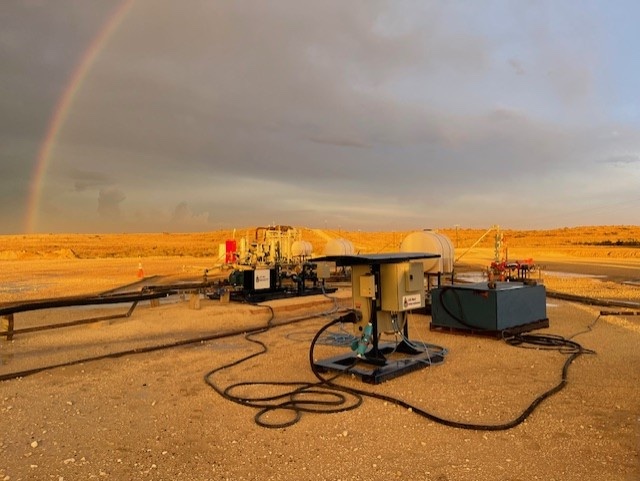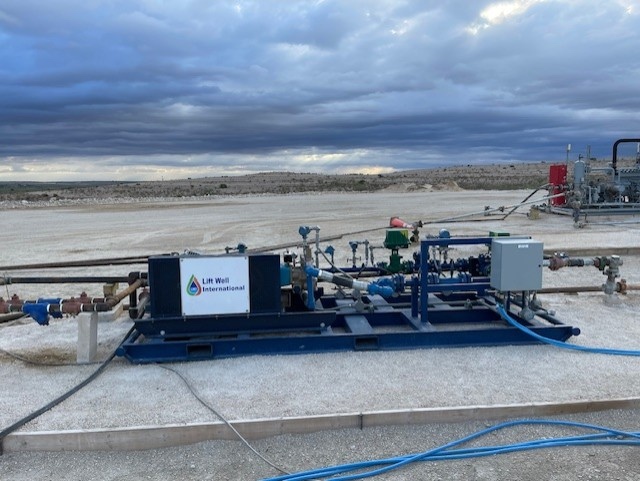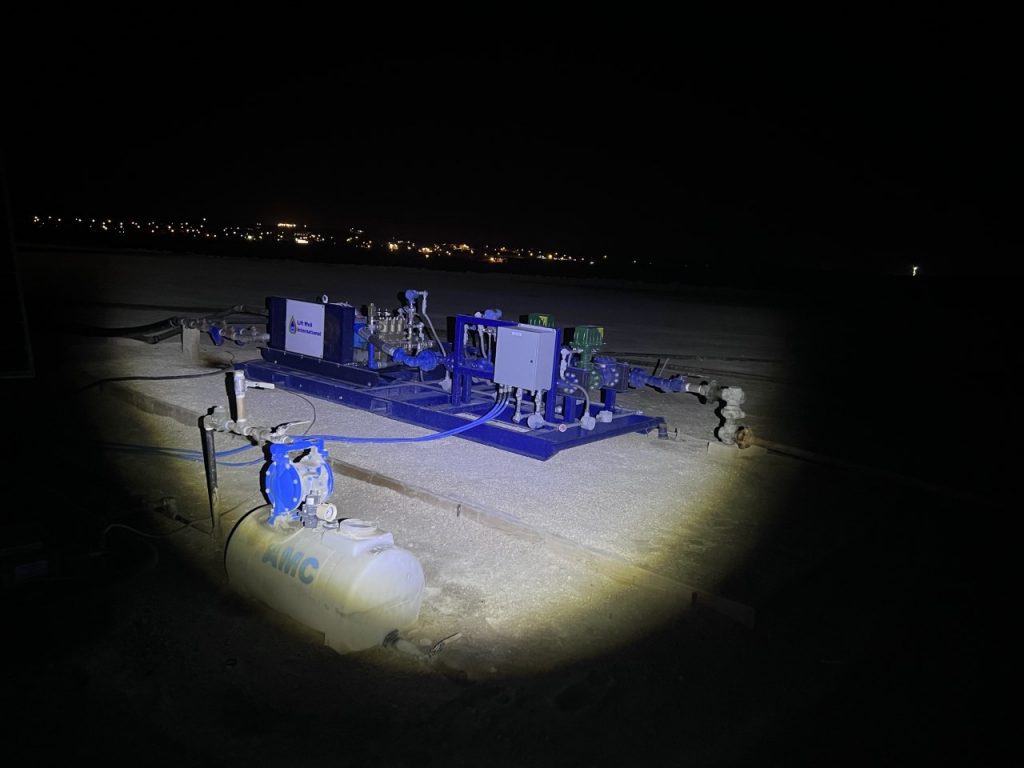Like a bartender short on lemons, oil and gas operators are intent on squeezing every drop of oil from every well at every stage of its life to meet global energy demands. New technology for hardware, well design, and management software are in the works for every type of lift, not just on the top end.
Humble end-of-life systems like rod pumps and plunger lift and progressive cavity pumps are getting makeovers as well as ESPs because, cumulatively, those stripper wells add up to thousands of barrels per day of production.
Then there’s one company with an outside-the-box twist on gas lift—called liquid assisted gas lift—that could shake things up all along the line.
For SLB, Seeing the Whole Picture in Real Time Is Key
Production from each well could be much more dependable and efficient if the current condition of each one were monitored and evaluated. Basically, fixing the issue of “You don’t know what you don’t know,” is the mantra for SLB’s Digital Project Manager for Artificial Lift, Mohammed El Gindy. Frequent, detailed monitoring, along with access to and evaluation of that data, can not only spot trends before they become failures, the resulting data can also inform adjustments to make production more efficient.
And that is what El Gindy is all about.
“In my opinion, artificial lift is the heart of production engineering because as long as we’re pumping, we’re keeping the well alive,” he said. El Gindy compared artificial lift to how the heart keeps people alive.
Frequency of monitoring is necessary because in the Permian, almost by definition, production declines, pressure always drops, and gas, sand, and water levels change over time. Therefore, pump speeds and types have to be adjusted—and the only way maximize those adjustments is to know, in real time, what’s happening on the well.
For operators, it’s all about “TCO, total cost of ownership. What we’re doing with customers has everything to do with everything that touches TCO,” El Gindy explained. That involves addressing three main areas. “The first one is equipment—equipment that is flexible, efficient, and easy to deploy. The second one is integration with elements closely related to the health of the system. And the third one is efficiency and measurements, which is the key enabler for the first two elements.”
All Working Together
The two main elements of TCO revolve around reducing workovers and keeping the pump operating efficiently as long as is possible, and across as wide a range of production rates as is practical. Right-sizing it for the initial production while keeping in mind the aforementioned progressive drops in flow rate and formation pressure, along with rises in free gas, water, and sand is the start. But it is just as important to monitor the pump and associated equipment at short intervals—hourly or more often—to determine whether all are staying within parameters.
“Many of the solutions today have been looking at how to ensure that you’re looking at the full life cycle of a field operation from day one to abandonment,” El Gindy said. That also informs operators of when, for example, the conditions have made it necessary to transition from an initial ESP to something else.
Gathering those measurements and analyzing them is the rest of the equation. Data stuck in the field doesn’t help, but even when communicated to the office, “It can be an overwhelming amount of data if you’re not managing it,” he said.
Combining current data with historical is what makes the recipe sizzle. History helps inform “What would have been the optimum performance versus the actual performance?”
To manage all this, SLB has recently released its Lumi data and AI platform, which unlocks access to data from disparate sources, using AI to process that information into actionable forms.
Progressive Cavity Pumps
PCPs are an area where SLB is plowing some new ground, El Gindy said. These pumps have historically been confined to heavy, low API oil—really not efficient for light, sweet crude common to the Permian and most U. S. oils.
But, said El Gindy, SLB has re-engineered this pump. The new Power Edge PCP “delivers 30-40 percent higher efficiency than ESPs for low flow rates and 20-30 percent higher efficiency than SRPs. The new PCP system works for light oil in conventional and unconventional wells, addresses efficiency concerns, allowing us to transition from high flow rates delivered by ESPs to lower flow rates at much higher efficiencies,” he explained.
Small Producer Data Tracking and Control
In today’s oil field the lift systems of thousands of new wells are being monitored and/or controlled remotely, which is saving operators millions of dollars in man-hours and workovers. But for ChampionX’s Senior Engineering Advisor Terry Treiberg, there are also around 100,000 marginal wells, almost always on rod pumps, whose production, generally at or less than 10 bbl/d, has generated too little income to pay for traditional automation. And while it’s true that a problem with any one of them would not be a blip on the corporate radar, there’s a cumulative effect.
“There’re operators out there that operate literally thousands of these stripper wells, so they add up.” Treiberg pointed out. Creating a limited but effective brand of automation specifically aimed at being cost-effective for stripper wells has been Treiberg’s passion. Recently, ChampionX released its SMARTEN Lite rod pump controller system to accomplish that goal. SMARTEN is part of the company’s Theta Production Optimization package.
Treiberg explained that SMARTEN economizes in a number of areas. “One of the ways you reduce costs is to cut out sensors and some capabilities. So it may not have all of the same capabilities [as full-scale automation], but we’re really after getting those basic remote surveillance and control capabilities.” Fewer sensors and less-frequent reporting are among them. And it comes with built-in communication software, simplifying installation.
One thing enabling this level of technology is the continuous downward arc of electronics pricing, making everything cheaper than 10 years ago, he said.
He sees this as of particular use in the Permian, which with its 100-plus-year history is host to thousands of these wells.
And it’s a huge step ahead of classic pump off controllers (POCs) that are based only on a timer whose on-off schedule may be either costing production by staying off too long or, if short-cycling, may be damaging rods and pumps with fluid pound in an unfilled pump. With monitoring, the operator can increase production and/or reduce pump damage. Either way, the SMARTEN system can more than pay for itself.
Perks for Plunger Lift
Plunger lift is another later-in-life lift system that’s under-monitored, said Treiberg, and that issue is what ChampionX’s Unify system addresses.
Plungers also are often on timers or a standalone controller unconnected to any network. “With that technology, we’re essentially running blind, so it’s better than nothing—but not a lot better because you really don’t know how it’s running,” said Treiberg.
In a way, it seems easy. “It’s a fairly simple form of artificial lift where we open and close one valve, but the timing of how long we leave it open, how long we leave it closed has a big impact on how that well operates,” he explained.
Unify, which is connected to the SMARTEN Lite package, looks to simplify the adoption process as well as monitoring and data analysis. “So we have low cost telemetry components combined with low cost processor components combined with software components that are also servers, and all the cloud computing that’s developed so much in the last few years,” Treiberg said. Bundling all those makes each of them more affordable.
In fact, costs have dropped so far that ChampionX had a serendipitous discovery—they could add more features than expected because costs were driven down on all of them.
Pump Placement as Future for Rod Pumps
BP Supply CEO Chris Parnell also sees new strategies for rod pumps, using placement designs to allow this classic system to adapt to unconventionals with long laterals.
“Much of the new technology we have seen regarding rod pumping has been concentrated on solving the issues of pumping ‘in the curve,’ ” he said. Placing the pump deep into the lateral improves production, but navigating the rod string through the curve at 45-60 degree inclination causes it to rub against the tubing, creating issues with friction. Those can be solved, but they’re expensive, and still offer shorter run life due to wear issues.
Alternatively, Parnell said, “This problem is currently being addressed not necessarily with new technology, but with a new configuration of existing bottom hole assembly technology. Rather than trying to set your pump in the curve, our data suggests a more optimal option is setting the pump right at the kickoff point and running a slimline tubing anchor with bottom hole assembly consisting of solids and gas separators that lower the fluid intake point down into the curve.
He continued, “This allows the operator to draw the annular fluid level further into the curve while allowing all the reciprocating portion of the system to remain relatively vertical. Although this does introduce slightly more complexity to the overall pumping system, it has proven to be the best solution thus far.”
On the hardware itself, Parnell noted that an increase in pump manufacturers has boosted competition, which has caused shops to boost quality control and higher quality materials in general, “All of which have contributed to longer product operating life.”
Using Analytics to Get Smarter
The universal in artificial lift today is getting and analyzing data to optimize production. Parnell says AI has allowed BP to analyze larger datasets “faster and from more angle,” giving them previously unattainable insights.
“When we combine data analytics with our own experience and common sense, it has allowed us to design rod pumps that result in real world performance. Through this process we have clients who have seen failure rates significantly improve. Additionally, we have found where data has shown we could achieve the same performance with more economical designs and/or metallurgies,” he explained.
That last part, maintaining performance with economical designs, is key to meeting client demands, he said. “In today’s market you must do more with less, faster, and better than anyone else.” He continued, “We have had to learn to be quick, agile, and adaptable because our clients’ demands change, and often.” Minimizing internal red tape and creating problem-solving synergies among staff are helping BP stay ahead of the curve, Parnell said.
Liftwell and the Liquid Assisted Gas Lift
At first it sounds crazy—pumping gas-enriched liquid downhole to lift liquid out of that same hole? But in lab and field alike, Liftwell International’s patent-pending method, referred to as Liquid Assisted Gas Lift (LAGL), is opening eyes of those who’ve seen it in the field.
The Short Version
The elevator pitch for Liftwell’s CEO / President / Co-Founder Tim Bridges and Co-Founder/Chief Technology Officer Dr. Paulo Waltrich—who is also an assistant professor at LSU—is basically this: It’s a lift system that works cradle-to-grave as a single surface-mounted pump, with cost and operation generally similar to that of gas lift. The surface pump and LIFTPOD are part of a system that combines natural gas with liquid, usually produced water, at the surface mixing T and keeps the gas commingled in the liquid at various densities from 100 percent liquid to 100 percent gas all the way to the producing formation and back to the surface.
The technology reduces the bottom hole pressure, allowing the formation pressure to lift that oil and gas to the surface. Unlike gas lift, it needs only a single injection point is at the bottom of the hole, reducing compression requirements by a factor of three.
Ease of service is a huge selling point. Says Bridges, “There’s no sub-surface equipment, so if something happens, the problem is on the surface where someone can go over, stop it for a moment, make a change and get back to production.” Most adjustments can be made remotely by computer.
And unlike an ESP, this is impervious to sand, to slugging, production declines, and other issues inherent in a mechanical device.
It Started with a Cleanout
While Bridges was not directly involved as the concept arose, he related that it began when the founder was employed by a major service company who was needing several months to unload fluid and frac sand out of low-bottom-hole pressure wells after fracs. When attempting to blow out the sand with high pressure gas injection, it “kind of worked” but was inefficient and expensive.
Next, they added a portable foam unit “to mix the air and the fluid with a chemical to make it a stable foam,” Bridges related. After some false trials, they cleaned the well out in one day.
Many years later one of the co-founders working for Shell asked LSU for research help. After many years of research, a team at LSU led by Dr. Waltrich completed the successful modeling of the technology. Lift Well International was founded and awarded a grant from Shell’s Game Changer program then the field trials and commercialization began.
The Secret Sauce
It’s all about keeping the gas suspended in the liquid across pressure and temperature changes all along the delivery path. Waltrich explained, “We have to find the right velocity of gas and liquid to keep them mixed enough that you don’t have stratification,” where gas rises and liquid falls, which would defeat the whole idea.
Keeping them together downhole requires carefully balanced compressors and equipment. The idea is to use the weight of the liquid to push the gas just by gravity, but the secret lies in keeping them mixed all the way to the bottom of the well.
The team then built a computer model for determining optimum rates for all types of wells and pipe sizes.
In the Field—Zero to 2300 bbl/d
Several field trials, stretching from the southern Permian to the Middle East, have proven the process. But Liftwell has been repeatedly stymied by mergers, acquisitions—and one pandemic—every time. They are not currently operating in the Permian, but of course would love to be here.
One field trial in a well that was on a pad with three long horizontal wells experiencing frac hits from nearby wells. All were dead, using high pressure single point gas (HPGL) injection.
After replacing the high-pressure boosters with the LIFTPOD, here were the results:
- The well was producing in less than four hours
- It started at a separator flowing 4500 bbl/d then averaged 2300 bbl/d
- Unloading pressure was 800 psi, 75 percent less than with HPGL
- The process used only 225 barrels of fluid
With low-hanging fruit drilled up, more and more industry experts are seeing future production levels depending on enhanced oil recovery and improved lifting options. These are just a few of the new options.
Paul Wiseman is a longtime freelance writer in the energy industry.















